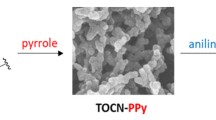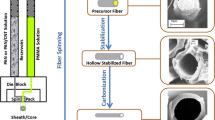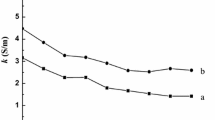Abstract
Polyaniline–cellulose acetate hollow fibers prepared from cellulose acetate (CA) solution of aniline (ANI) were founded to show dual layers structure, when wet technique was applied for using syringe injection of the solution to acidic water for ANI polymerization. In this technique, the polymerization of ANI occurred simultaneously by the monomer injection in coagulated CA fibers. Then, the PANI–CA composite fibers were obtained. The formation of the PANI–CA composite fiber was dependent upon HCl concentration and initiator of ammonium persulfate. Especially, when the coagulation time was 1 min, the obtained PANI–CA fibers showed hollowed dual-layer structure having outer layer of PANI and inner layer of CA. Evidence was presented that the dual structure fiber had 40 μm outer layer and 60 μm inner porous layer in their thicknesses. Cyclic voltammograms of the PANI–CA fiber were indicated that the outer layer was composed of PANI layer showing electrochemical properties with electrical capacity of about 0.003 C.









Similar content being viewed by others
References
Khan AA, Paquiza L (2011) Characterization and ion-exchange behavior of thermally stable nano-composite polyaniline zirconium titanium phosphate: its analytical application in separation of toxic metals. Desalination 265:242–254
Moon D-K, Ezuka M, Maruyama T, Osakada K, Yamamoto T (1993) Kinetic study on chemical oxidation of leucoemeraldine base polyaniline to emeraldine base. Macromolecules 26:364–369
Smela E, Wen L, Mattes BR (2005) Polyaniline actuators Part 1. PANI(AMPS) in HCl. Synth Met 151:25–42
Chen Y, Zhu H, Liu Y (2011) Preparation of activated rectangular polyaniline-based carbon tubes and their application in hydrogen absorption. Int J Hydrogen Energy 36:11738–11745
Jiang N, Yiting X, Dai Y, Luo W, Dai L (2012) Polyaniline nanofibers assembled on alginate microsphere for Cu2+ and Pb2+ uptake. J Hazard Mater 215–216:12–24
Cerqueira DA, Valente AJM, Filho GR, Burrows HD (2009) Synthesis and properties of polyaniline–cellulose acetate blends: the use of sugarcane bagasse waste and the effect of the substitution degree. Carbohydr Polym 78:402–408
Szamel G, Domjan A, Klebert S, Pukanszky B (2008) Molecular structure and properties of cellulose acetate chemically modified with caprolactone. Euro Polym J 44:357–365
Rama Rao P, Diwan PV (1997) Permeability studies of cellulose acetate free films for transdermal use: influence of plasticizers. Pharm Acta Helv 72:47–51
Lazarin AM, Borgo CA, Gushiken Y (2003) A platinum electrode coated with a copper (II) aminopropyl complex-cellulose acetate membrane and its use for dissolved oxygen reduction. J Membr Sci 221:175–184
Morita R, Khan FZ, Sakaguchi T, Shiotsuki M, Nishio Y, Masuda T (2007) Synthesis, characterization, and permeation properties of the silyl derivatives of cellulose acetate. J Membr Sci 305:136–145
Takano T, Mikazuki A, Kobayashi T (2013) Conductive polypyrrole composite films prepared using wet cast technique with a pyrrole–cellulose acetate solution. Polym Eng Sci (in press)
Mao Z, Jie X, Cao Y, Wang L, Li M, Yuan Q (2011) Preparation of dual-layer cellulose/polysulfone hollow fiber membrane and its performance for isopropanol dehydration and CO2 separation. Sep Purif Technol 77:179–184
Liu C, Bai R (2005) Preparation of chitosan/cellulose acetate blend hollow fibers for absorptive performance. J Membr Sci 267:68–77
Son LT, Takaomi K (2011) Hollow-fiber membrane absorbents embedded molecularly imprinted polymeric spheres for bisphenol A target. J Membr Sci 384:117–125
Liu SH, Luo GS, Wang Y, Wang YJ (2003) Preparation of coiled hollow-fiber membrane and mass transfer performance in membrane extraction. J Membr Sci 215:203–211
Jie X, Cao Y, Qin J-J, Liu J, Yuan Q (2005) Influence of drying method on morphology and properties of asymmetric cellulose hollow fiber membrane. J Membr Sci 246:157–165
He T, Mulder MHV, Strathmann H, Wessling M (2002) Preparation of composite hollow fiber membranes: co-extrusion of hydrophilic coatings onto porous hydrophobic support structures. J Membr Sci 207:143–156
Ismail AF, Mustaffar MI, Illias RM, Abdullah MS (2006) Effect of dope extrusion rate on morphology and performance of hollow fibers membrane for ultrafiltration. Sep Purif Technol 49:10–19
Kulkarni SB, Joshi SS, Lokhande CD (2011) Facile and efficient route for preparation of nanostructured polyaniline thin films: schematic model for simplest oxidative chemical polymerization. Chem Eng J 166:1179–1185
Murphy D, de Phnho MN (1995) An ATR-FTIR study of water in cellulose acetate membranes prepared by phase inversion. J Membr Sci 106:245–257
Pielesz A, Binias W (2010) Cellulose acetate membrane electrophoresis and FTIR spectroscopy as methods of identifying a fucoidan in Fucus vesiculosus Linnaeus. Carbohydr Res 345:2676–2682
Dispenza C, Sabatino MA, Chmielewska D, LoPresti C, Battaglia G (2012) Inherently fluorescent polyaniline nanoparticles in dynamic landscape. React Funct Polym 72:185–197
Trchova M, Matejka P, Brodinova J, Kalendova A, Prokes J, Stejskal J (2006) Structural and conductivity changes during the pyrolysis of the polyaniline base. Polym Degrad Stab 91:114–121
Trchova M, Sedenkova I, Tobolkova E, Stejskal J (2004) FTIR spectroscopic and conductivity study of the thermal degradation of polyaniline films. Polym Degrad Stab 86:179–185
Valente AJM, Burrows HD, Lobo VMM (2006) Sorption of sodium dodecyl sulfate by polyaniline–cellulose acetate polymeric blends as seen by UV–vis spectroscopy. Colloids Surf A Physicochem Eng Aspects 275:221–227
Wang Y, Jing X (2005) Effect of solution concentration on the UV–vis spectroscopy measured oxidation state of polyaniline base. Polym Testing 24:153–156
de Azevedo WM, de Souza JM, de Melo JV (1999) Semi-interpenetrating polymer networks based on polyaniline and polyvinyl alcohol-glutaraldehyde/. Synth Met 100:241–248
de Albuquerque JE, Mattoso LHC, Faria RM, Masters JG, MacDiarmid AG (2004) Study of the interconversion of polyaniline oxidation states by optical absorption spectroscopy. Synth Met 146:1–10
Lizarraga L, Andrade EM, Molina FV (2004) Swelling and volume changes of polyaniline upon redox switching. J Electroanal Chem 561:127–135
Parys B, Celuch P (2006) Redox transformations of polyaniline nanotubes cyclic voltammetry, infrared and optical absorption studies. Electrochim Acta 51:4115–4124
Trung T, Trung TH, Ha C-S (2005) Preparation and cyclic voltammetry studies on nickel-nanoclusters containing polyaniline composites having layer-by-layer structures. Electrochim Acta 51:984–990
Bonastre AM, Bartlett PN (2010) Electrodeposition of PANi films on platinum needle type microelectrodes. Application to the oxidation of ascorbate in human plasma. Anal Chim Acta 676:1–8
Namazi H, Kabiri R, Entezami A (2002) Determination of extremely low percolation threshold electroactivity of the blend polyvinyl chloride/polyaniline doped with camphorsulfonic acid by cyclic voltammetry method. Eur Polymer J 38:771–777
Qi K, Qiu Y, Chen Z, Guo X (2012) Corrosion of conductive polypyrrole: effects of environmental factors, electrochemical stimulation, and doping anions. Corros Sci 60:50–58
Huang HG, Zheng ZX, Luo J, Zhang HP, Wu LL, Lin ZH (2001) Internal photoemission in polyaniline revealed by photoelectrochemistry. Synth Met 123:321–325
Yang D, Wen L, Goering R, Mattes BR (2009) Investigation of polyaniline processibility using GPC/UV–vis analysis. Synth Met 159:666–674
Author information
Authors and Affiliations
Corresponding author
Rights and permissions
About this article
Cite this article
Takano, T., Tagaya, M. & Kobayashi, T. Dual-layer hollow fiber of polyaniline–cellulose acetate prepared with simple wet technique of chemical polymerization of aniline. Polym. Bull. 70, 3019–3030 (2013). https://doi.org/10.1007/s00289-013-1004-2
Received:
Revised:
Accepted:
Published:
Issue Date:
DOI: https://doi.org/10.1007/s00289-013-1004-2




